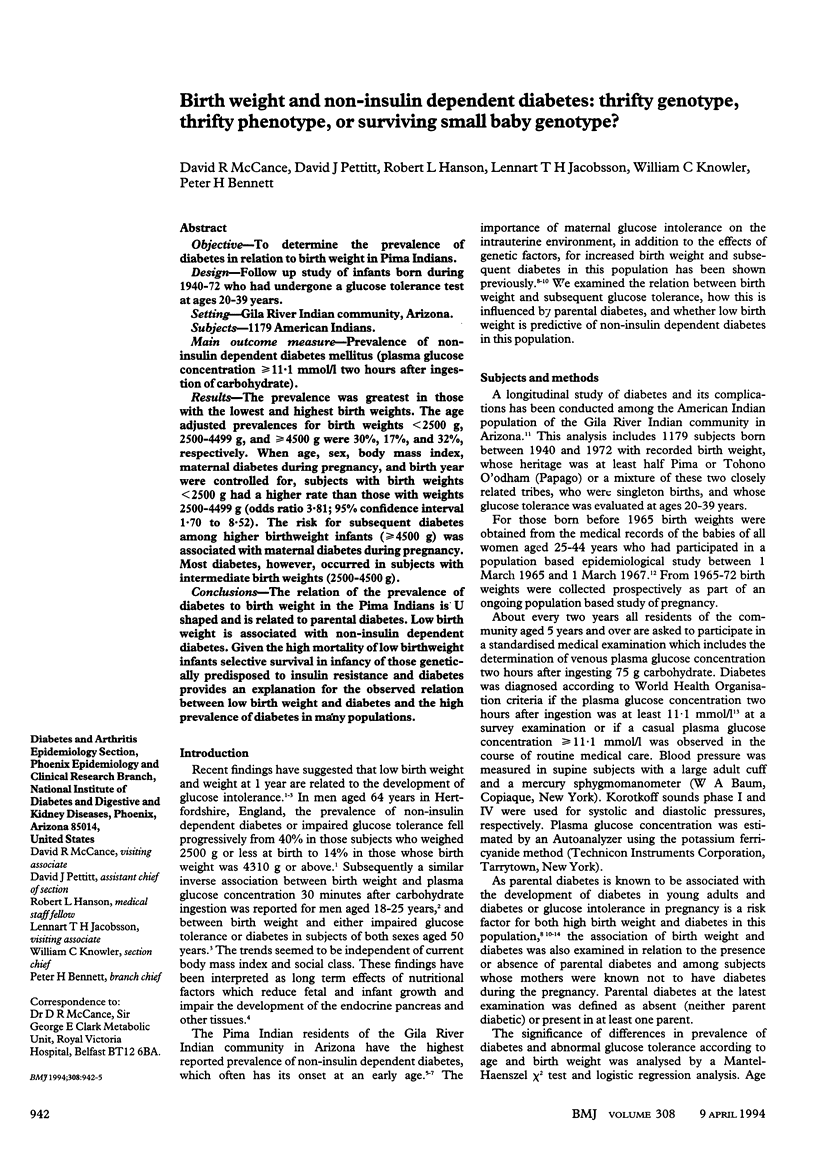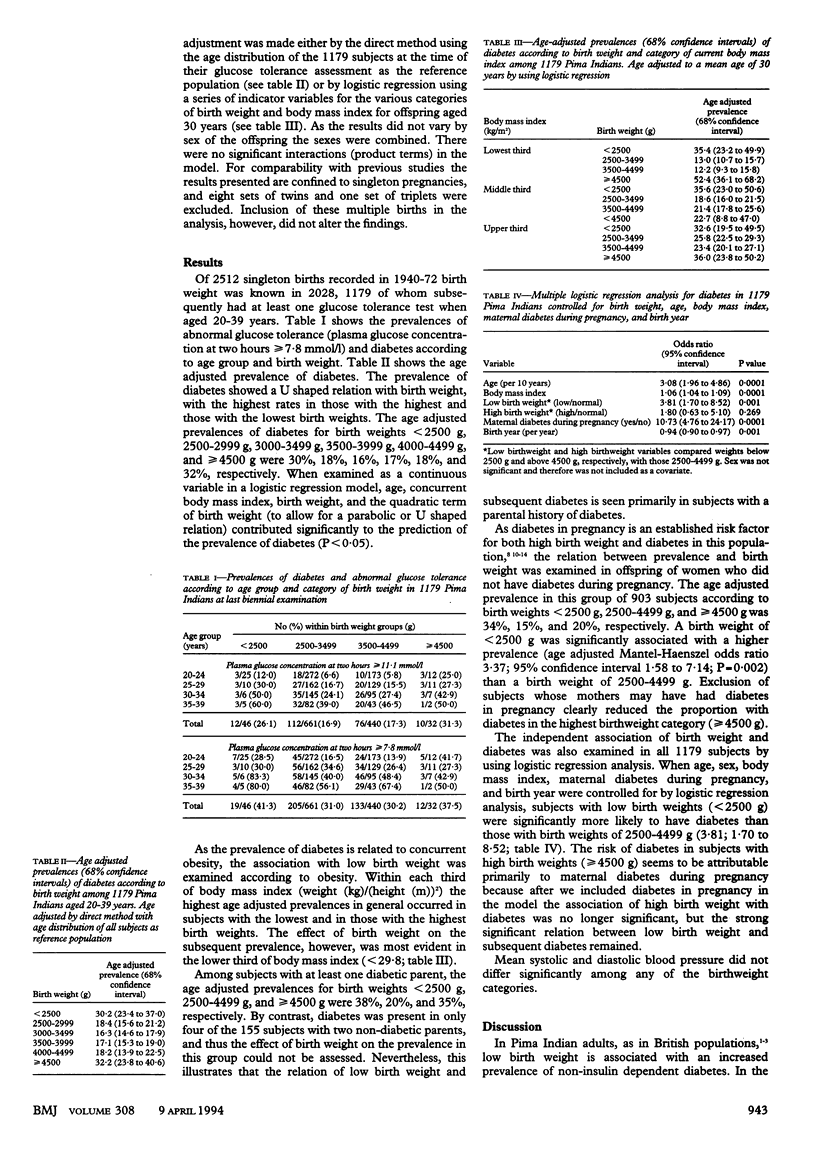Abstract
OBJECTIVE--To determine the prevalence of diabetes in relation to birth weight in Pima Indians. DESIGN--Follow up study of infants born during 1940-72 who had undergone a glucose tolerance test at ages 20-39 years. SETTING--Gila River Indian community, Arizona. SUBJECTS--1179 American Indians. MAIN OUTCOME MEASURE--Prevalence of non-insulin dependent diabetes mellitus (plasma glucose concentration > or = 11.1 mmol/l two hours after ingestion of carbohydrate). RESULTS--The prevalence was greatest in those with the lowest and highest birth weights. The age adjusted prevalences for birth weights < 2500 g, 2500-4499 g, and > or = 4500 g were 30%, 17%, and 32%, respectively. When age, sex, body mass index, maternal diabetes during pregnancy, and birth year were controlled for, subjects with birth weights < 2500 g had a higher rate than those with weights 2500-4499 g (odds ratio 3.81; 95% confidence interval 1.70 to 8.52). The risk for subsequent diabetes among higher birthweight infants (> or = 4500 g) was associated with maternal diabetes during pregnancy. Most diabetes, however, occurred in subjects with intermediate birth weights (2500-4500 g). CONCLUSIONS--The relation of the prevalence of diabetes to birth weight in the Pima Indians is U shaped and is related to parental diabetes. Low birth weight is associated with non-insulin dependent diabetes. Given the high mortality of low birthweight infants selective survival in infancy of those genetically predisposed to insulin resistance and diabetes provides an explanation for the observed relation between low birth weight and diabetes and the high prevalence of diabetes in many populations.
Full text
PDF



Selected References
These references are in PubMed. This may not be the complete list of references from this article.
- Barker D. J., Hales C. N., Fall C. H., Osmond C., Phipps K., Clark P. M. Type 2 (non-insulin-dependent) diabetes mellitus, hypertension and hyperlipidaemia (syndrome X): relation to reduced fetal growth. Diabetologia. 1993 Jan;36(1):62–67. doi: 10.1007/BF00399095. [DOI] [PubMed] [Google Scholar]
- Bennett P. H., Burch T. A., Miller M. Diabetes mellitus in American (Pima) Indians. Lancet. 1971 Jul 17;2(7716):125–128. doi: 10.1016/s0140-6736(71)92303-8. [DOI] [PubMed] [Google Scholar]
- Comess L. J., Bennett P. H., Burch T. A., Miller M. Congenital anomalies and diabetes in the Prima Indians of Arizona. Diabetes. 1969 Jul;18(7):471–477. doi: 10.2337/diab.18.7.471. [DOI] [PubMed] [Google Scholar]
- Freinkel N. Banting Lecture 1980. Of pregnancy and progeny. Diabetes. 1980 Dec;29(12):1023–1035. doi: 10.2337/diab.29.12.1023. [DOI] [PubMed] [Google Scholar]
- Hales C. N., Barker D. J., Clark P. M., Cox L. J., Fall C., Osmond C., Winter P. D. Fetal and infant growth and impaired glucose tolerance at age 64. BMJ. 1991 Oct 26;303(6809):1019–1022. doi: 10.1136/bmj.303.6809.1019. [DOI] [PMC free article] [PubMed] [Google Scholar]
- Hales C. N., Barker D. J. Type 2 (non-insulin-dependent) diabetes mellitus: the thrifty phenotype hypothesis. Diabetologia. 1992 Jul;35(7):595–601. doi: 10.1007/BF00400248. [DOI] [PubMed] [Google Scholar]
- Knowler W. C., Bennett P. H., Hamman R. F., Miller M. Diabetes incidence and prevalence in Pima Indians: a 19-fold greater incidence than in Rochester, Minnesota. Am J Epidemiol. 1978 Dec;108(6):497–505. doi: 10.1093/oxfordjournals.aje.a112648. [DOI] [PubMed] [Google Scholar]
- Knowler W. C., Pettitt D. J., Saad M. F., Bennett P. H. Diabetes mellitus in the Pima Indians: incidence, risk factors and pathogenesis. Diabetes Metab Rev. 1990 Feb;6(1):1–27. doi: 10.1002/dmr.5610060101. [DOI] [PubMed] [Google Scholar]
- Lillioja S., Mott D. M., Howard B. V., Bennett P. H., Yki-Järvinen H., Freymond D., Nyomba B. L., Zurlo F., Swinburn B., Bogardus C. Impaired glucose tolerance as a disorder of insulin action. Longitudinal and cross-sectional studies in Pima Indians. N Engl J Med. 1988 May 12;318(19):1217–1225. doi: 10.1056/NEJM198805123181901. [DOI] [PubMed] [Google Scholar]
- Lillioja S., Mott D. M., Spraul M., Ferraro R., Foley J. E., Ravussin E., Knowler W. C., Bennett P. H., Bogardus C. Insulin resistance and insulin secretory dysfunction as precursors of non-insulin-dependent diabetes mellitus. Prospective studies of Pima Indians. N Engl J Med. 1993 Dec 30;329(27):1988–1992. doi: 10.1056/NEJM199312303292703. [DOI] [PubMed] [Google Scholar]
- Martin B. C., Warram J. H., Krolewski A. S., Bergman R. N., Soeldner J. S., Kahn C. R. Role of glucose and insulin resistance in development of type 2 diabetes mellitus: results of a 25-year follow-up study. Lancet. 1992 Oct 17;340(8825):925–929. doi: 10.1016/0140-6736(92)92814-v. [DOI] [PubMed] [Google Scholar]
- McCance R. A., Widdowson E. M. The determinants of growth and form. Proc R Soc Lond B Biol Sci. 1974 Jan 22;185(1078):1–17. doi: 10.1098/rspb.1974.0001. [DOI] [PubMed] [Google Scholar]
- Pettitt D. J., Aleck K. A., Baird H. R., Carraher M. J., Bennett P. H., Knowler W. C. Congenital susceptibility to NIDDM. Role of intrauterine environment. Diabetes. 1988 May;37(5):622–628. doi: 10.2337/diab.37.5.622. [DOI] [PubMed] [Google Scholar]
- Pettitt D. J., Baird H. R., Aleck K. A., Bennett P. H., Knowler W. C. Excessive obesity in offspring of Pima Indian women with diabetes during pregnancy. N Engl J Med. 1983 Feb 3;308(5):242–245. doi: 10.1056/NEJM198302033080502. [DOI] [PubMed] [Google Scholar]
- Pettitt D. J., Bennett P. H., Saad M. F., Charles M. A., Nelson R. G., Knowler W. C. Abnormal glucose tolerance during pregnancy in Pima Indian women. Long-term effects on offspring. Diabetes. 1991 Dec;40 (Suppl 2):126–130. doi: 10.2337/diab.40.2.s126. [DOI] [PubMed] [Google Scholar]
- Pettitt D. J., Knowler W. C., Baird H. R., Bennett P. H. Gestational diabetes: infant and maternal complications of pregnancy in relation to third-trimester glucose tolerance in the Pima Indians. Diabetes Care. 1980 May-Jun;3(3):458–464. doi: 10.2337/diacare.3.3.458. [DOI] [PubMed] [Google Scholar]
- Phipps K., Barker D. J., Hales C. N., Fall C. H., Osmond C., Clark P. M. Fetal growth and impaired glucose tolerance in men and women. Diabetologia. 1993 Mar;36(3):225–228. doi: 10.1007/BF00399954. [DOI] [PubMed] [Google Scholar]
- Robinson S., Walton R. J., Clark P. M., Barker D. J., Hales C. N., Osmond C. The relation of fetal growth to plasma glucose in young men. Diabetologia. 1992 May;35(5):444–446. doi: 10.1007/BF02342441. [DOI] [PubMed] [Google Scholar]
- Swenne I., Bone A. J., Howell S. L., Hellerström C. Effects of glucose and amino acids on the biosynthesis of DNA and insulin in fetal rat islets maintained in tissue culture. Diabetes. 1980 Sep;29(9):686–692. doi: 10.2337/diab.29.9.686. [DOI] [PubMed] [Google Scholar]
- Swenne I., Crace C. J., Milner R. D. Persistent impairment of insulin secretory response to glucose in adult rats after limited period of protein-calorie malnutrition early in life. Diabetes. 1987 Apr;36(4):454–458. doi: 10.2337/diab.36.4.454. [DOI] [PubMed] [Google Scholar]
- Wilkin T. J. Early nutrition and diabetes mellitus. BMJ. 1993 Jan 30;306(6873):283–284. doi: 10.1136/bmj.306.6873.283. [DOI] [PMC free article] [PubMed] [Google Scholar]
- van Assche F. A., Aerts L. The fetal endocrine pancreas. Contrib Gynecol Obstet. 1979;5:44–57. [PubMed] [Google Scholar]


